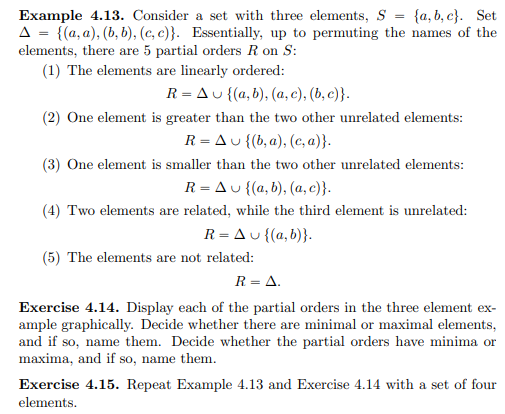Example 4.13. Consider a set with three elements, s = {a,b, c}. Set A = {(a,a), (b, b), (c, c)}. Essentially, up to permuting the names of the elements, there are 5 partial orders R on S: (1) The elements are linearly ordered: R = Au {(a,b), (a, c), (b, c)}. (2) One element is greater than the two other unrelated elements: R= Au {(b, a), (c, a)}. (3) One element is smaller than the two other unrelated elements: R = Au {(a, b), (a, c)}. (4) Two elements are related, while the third element is unrelated: R=Δυ (α, ). . (5) The elements are not related: R=A. Exercise 4.14. Display each of the partial orders in the three element ex- ample graphically. Decide whether there are minimal or maximal elements, and if so, name them. Decide whether the partial orders have minima or maxima, and if so, name them. Exercise 4.15. Repeat Example 4.13 and Exercise 4.14 with a set of four elements.
Example 4.13. Consider a set with three elements, s = {a,b, c}. Set A = {(a,a), (b, b), (c, c)}. Essentially, up to permuting the names of the elements, there are 5 partial orders R on S: (1) The elements are linearly ordered: R = Au {(a,b), (a, c), (b, c)}. (2) One element is greater than the two other unrelated elements: R= Au {(b, a), (c, a)}. (3) One element is smaller than the two other unrelated elements: R = Au {(a, b), (a, c)}. (4) Two elements are related, while the third element is unrelated: R=Δυ (α, ). . (5) The elements are not related: R=A. Exercise 4.14. Display each of the partial orders in the three element ex- ample graphically. Decide whether there are minimal or maximal elements, and if so, name them. Decide whether the partial orders have minima or maxima, and if so, name them. Exercise 4.15. Repeat Example 4.13 and Exercise 4.14 with a set of four elements.
Linear Algebra: A Modern Introduction
4th Edition
ISBN:9781285463247
Author:David Poole
Publisher:David Poole
Chapter2: Systems Of Linear Equations
Section2.4: Applications
Problem 32EQ
Related questions
Topic Video
Question
100%
Please do Exercise 4.15. I have included 4.13 and 4.14 for your reference as well. And please keep it short and simple with typefont or legible handwriting, and clear explanations for each step. Thank you!

Transcribed Image Text:Example 4.13. Consider a set with three elements, s = {a,b, c}. Set
A = {(a,a), (b, b), (c, c)}. Essentially, up to permuting the names of the
elements, there are 5 partial orders R on S:
(1) The elements are linearly ordered:
R = Au {(a,b), (a, c), (b, c)}.
(2) One element is greater than the two other unrelated elements:
R= Au {(b, a), (c, a)}.
(3) One element is smaller than the two other unrelated elements:
R = Au {(a, b), (a, c)}.
(4) Two elements are related, while the third element is unrelated:
R=Δυ (α, ). .
(5) The elements are not related:
R=A.
Exercise 4.14. Display each of the partial orders in the three element ex-
ample graphically. Decide whether there are minimal or maximal elements,
and if so, name them. Decide whether the partial orders have minima or
maxima, and if so, name them.
Exercise 4.15. Repeat Example 4.13 and Exercise 4.14 with a set of four
elements.
Expert Solution
This question has been solved!
Explore an expertly crafted, step-by-step solution for a thorough understanding of key concepts.
This is a popular solution!
Trending now
This is a popular solution!
Step by step
Solved in 4 steps with 8 images

Knowledge Booster
Learn more about
Need a deep-dive on the concept behind this application? Look no further. Learn more about this topic, advanced-math and related others by exploring similar questions and additional content below.Recommended textbooks for you

Linear Algebra: A Modern Introduction
Algebra
ISBN:
9781285463247
Author:
David Poole
Publisher:
Cengage Learning

Elements Of Modern Algebra
Algebra
ISBN:
9781285463230
Author:
Gilbert, Linda, Jimmie
Publisher:
Cengage Learning,

Elementary Linear Algebra (MindTap Course List)
Algebra
ISBN:
9781305658004
Author:
Ron Larson
Publisher:
Cengage Learning

Linear Algebra: A Modern Introduction
Algebra
ISBN:
9781285463247
Author:
David Poole
Publisher:
Cengage Learning

Elements Of Modern Algebra
Algebra
ISBN:
9781285463230
Author:
Gilbert, Linda, Jimmie
Publisher:
Cengage Learning,

Elementary Linear Algebra (MindTap Course List)
Algebra
ISBN:
9781305658004
Author:
Ron Larson
Publisher:
Cengage Learning